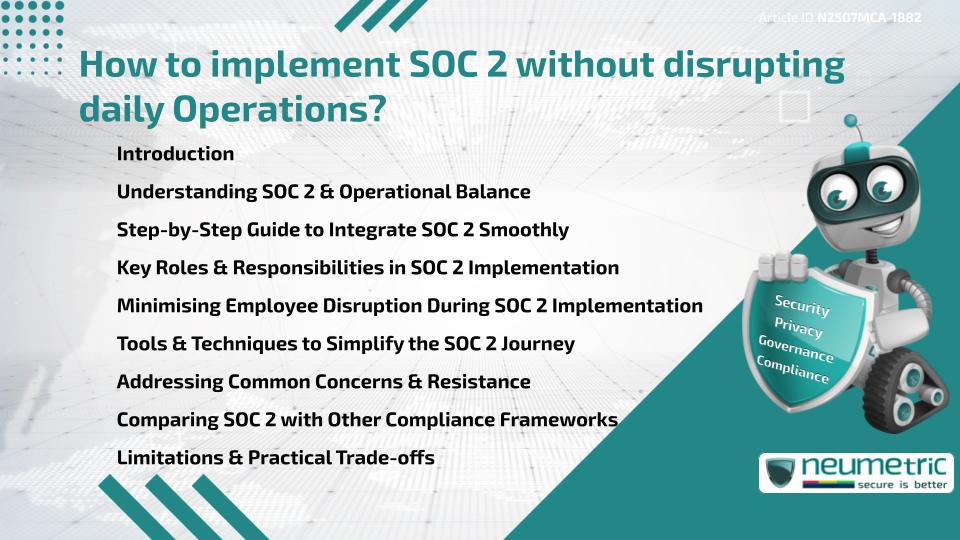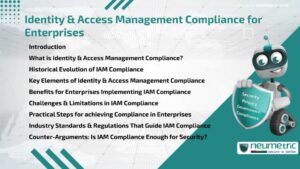Table of Contents
ToggleIntroduction
How to implement SOC 2 without disrupting daily operations is a common concern for growing companies seeking compliance without compromising productivity. SOC 2 [System & organisation Controls 2] is essential for organisations handling sensitive Customer Data. Yet, the fear of slowing down everyday tasks can delay this critical step.
In this article, we explore how to implement SOC 2 effectively while preserving your business momentum. We break down the process into clear steps, examine typical challenges & offer practical methods to make compliance feel less like a burden & more like a business enabler.
We also compare SOC 2 with other frameworks, discuss its limitations & share tools that make the journey smoother for teams of any size.
Understanding SOC 2 & Operational Balance
SOC 2 is a compliance Standard based on five principles: Security, Availability, Processing Integrity, Confidentiality & Privacy. Its goal is to ensure your systems & processes are reliable & trustworthy.
However, implementing SOC 2 can be disruptive if not carefully planned. Operations teams often fear increased workloads, rigid changes or unclear roles. To avoid these disruptions, companies must align their SOC 2 planning with their Business Objectives & Customer Expectations.
This primer from CSRC helps understand how to align technical standards with operational design principles.
Step-by-Step Guide to Integrate SOC 2 Smoothly
Understanding how to implement SOC 2 begins with setting a realistic timeline. Here’s a simplified roadmap:
- Assessment: Evaluate your current controls & identify gaps.
- Scope Definition: Decide what systems, processes & data fall under SOC 2.
- Policy Drafting: Establish or update Security Policies.
- Tool Selection: Choose automation tools that fit your workflow.
- Employee Training: Educate staff to follow updated procedures.
- Monitoring: Ensure controls are working as intended before Audit.
This process can take between three (3) to nine (9) months depending on your company’s size & preparedness.
Cloud Security Alliance offers helpful resources to understand how control frameworks interact with cloud environments.
Key Roles & Responsibilities in SOC 2 Implementation
Role clarity is a game changer. Without it, tasks get delayed or duplicated.
- Executive Sponsor: Sets vision & allocates budget.
- Compliance Lead: Coordinates implementation efforts.
- IT & DevOps: Manage tools & secure configurations.
- HR: Helps roll out Policies & training.
- Internal Auditor: Tracks progress & pre-Audit readiness.
By assigning responsibilities early, you reduce confusion & keep operations flowing.
Minimising Employee Disruption During SOC 2 Implementation
Daily operations shouldn’t stop for SOC 2. Some ways to ensure minimal disruption include:
- Start Small: Begin with one (1) team or department to pilot processes.
- Use Existing Tools: Leverage what’s already in use, like Slack or Jira, instead of introducing unfamiliar platforms.
- Embed Tasks into Workflow: For example, add policy acknowledgments to onboarding checklists.
- Regular Updates: Communicate status to reduce anxiety & gain buy-in.
Employees resist change when they don’t understand it. Early & frequent communication can change that.
Tools & Techniques to Simplify the SOC 2 Journey
Automation is your ally. Tools that help simplify how to implement SOC 2 include:
- GRC Platforms: Manage Policies, evidence & Audit timelines.
- Monitoring Tools: Alert on system changes or security breaches.
- Ticketing Systems: Track compliance tasks alongside regular work.
- Document Templates: Reduce time writing Policies from scratch.
MITRE ATTACK offers open-source knowledge that supports robust monitoring & detection methods.
Addressing Common Concerns & Resistance
Employees often worry about time consumption or additional bureaucracy. Here’s how to counter those:
- Time Concerns: Highlight automation that reduces manual work.
- Privacy Concerns: Clarify what data is being monitored & why.
- Compliance Myths: Address false ideas, such as “SOC 2 is only for tech companies.”
Use town halls or lunch-and-learn sessions to answer questions & ease tensions.
Comparing SOC 2 with Other Compliance Frameworks
Understanding how to implement SOC 2 is easier when you see how it stacks up against others:
- ISO 27001: More global, broader in scope, but also more rigid.
- HIPAA: Specific to Healthcare, strong on Privacy but narrow.
- PCI DSS: Focused on cardholder data, very prescriptive.
SOC 2 is often chosen by service providers due to its flexible nature & relevance to Client data assurance.
ISACA provides valuable insights into comparative frameworks & Audit methods.
Limitations & Practical Trade-offs
Even the best approach has limits. SOC 2 doesn’t cover legal compliance or Financial controls. It focuses on trust principles, which may not fully overlap with every business requirement.
Also, the Audit is only a snapshot in time. Maintaining compliance means continuous attention.
Finally, small teams may find resource allocation challenging without external support.
Takeaways
- Understand your systems & operations before starting.
- Align SOC 2 controls with your ongoing workflows.
- Assign clear roles & responsibilities.
- Use tools that automate evidence collection & monitoring.
- Keep communication open to reduce resistance & confusion.
FAQ
What is SOC 2 & why is it important for service providers?
SOC 2 is a Framework that assesses how organisations manage Customer Data. It’s important because it assures clients about your data handling practices.
Can small companies implement SOC 2 without extra staff?
Yes, with careful planning & the right tools, small teams can manage SOC 2 implementation by distributing roles efficiently.
How long does it take to implement SOC 2?
It usually takes between three (3) to nine (9) months depending on company size, current maturity & level of documentation.
Do we need to stop other work while doing SOC 2?
No, if properly planned, SOC 2 tasks can run in parallel with regular operations by embedding them into normal routines.
Is SOC 2 required by law?
No, SOC 2 is not legally required, but it is often requested by clients or partners as a trust & assurance measure.
How often do we need to renew SOC 2 compliance?
SOC 2 reports are typically valid for one (1) year. Continuous Monitoring & annual audits are recommended.
What kind of evidence is required for SOC 2?
Evidence includes Policies, access logs, monitoring reports & proof of Employee Training or background checks.
How does SOC 2 differ from ISO 27001?
SOC 2 is more flexible & Client-focused, while ISO 27001 is a formal Certification Standard with a fixed structure.
Can SOC 2 be implemented in agile environments?
Yes, agile teams can align SOC 2 controls with their sprints, using automation to handle documentation & tracking.
Need help?
Neumetric provides organisations the necessary help to achieve their Cybersecurity, Compliance, Governance, Privacy, Certifications & Pentesting goals.
Organisations & Businesses, specifically those which provide SaaS & AI Solutions, usually need a Cybersecurity Partner for meeting & maintaining the ongoing Security & Privacy needs & requirements of their Clients & Customers.
SOC 2, ISO 27001, ISO 42001, NIST, HIPAA, HECVAT, EU GDPR are some of the Frameworks that are served by Fusion – a centralised, automated, AI-enabled SaaS Solution created & managed by Neumetric.
Reach out to us!





